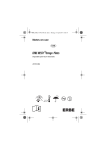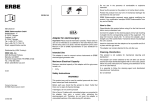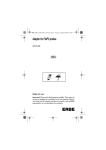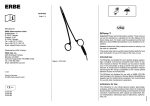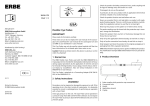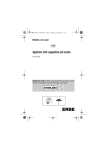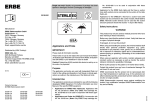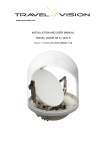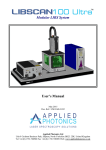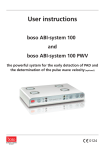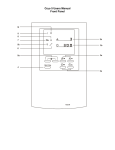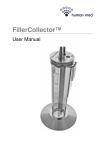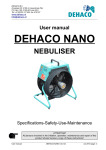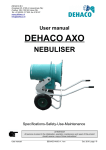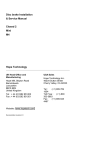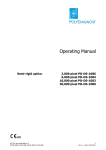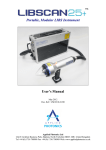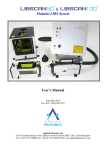Download APC-handles
Transcript
OBJ_DOKU-185032-005.fm Seite 1 Montag, 18. November 2013 1:33 13 Notes on use usa APC-handles 20132-208, 20132-209 OBJ_DOKU-185032-005.fm Seite 2 Montag, 18. November 2013 1:33 13 Table of Contents 1 2 3 4 5 6 IMPORTANT! . . . . . . . . . . . . . . . . . . . . . . . . . . . . . . . 3 Product Description. . . . . . . . . . . . . . . . . . . . . . . . . . 3 Normal Use . . . . . . . . . . . . . . . . . . . . . . . . . . . . . . . . 4 Maximum Electrical Capacity. . . . . . . . . . . . . . . . . . . 4 Safety Instructions . . . . . . . . . . . . . . . . . . . . . . . . . . 4 How to Use . . . . . . . . . . . . . . . . . . . . . . . . . . . . . . . . 7 5.1 Only use sterile products . . . . . . . . . . . . . . . . . . . . . 7 5.2 Check the product . . . . . . . . . . . . . . . . . . . . . . . . . . 7 5.3 Assembling the product . . . . . . . . . . . . . . . . . . . . . . 8 5.4 Connect the product . . . . . . . . . . . . . . . . . . . . . . . . 8 5.5 Conducting a performance test . . . . . . . . . . . . . . . . 9 Cleaning, Disinfection, Sterilization. . . . . . . . . . . . . 10 6.1 Safety Instructions . . . . . . . . . . . . . . . . . . . . . . . . . 10 6.2 Reconditioning Limitation . . . . . . . . . . . . . . . . . . . 11 6.3 Recommended Processing Agents/Equipment . . . . 11 6.4 Recommended Methods . . . . . . . . . . . . . . . . . . . . 11 6.5 Required Aids . . . . . . . . . . . . . . . . . . . . . . . . . . . . 12 6.6 Disassembly . . . . . . . . . . . . . . . . . . . . . . . . . . . . . . 12 6.7 Precleaning . . . . . . . . . . . . . . . . . . . . . . . . . . . . . . 13 6.8 Manual Cleaning and Disinfection . . . . . . . . . . . . . 13 6.9 Cleaning and Disinfection by Machine . . . . . . . . . . 15 6.10 Check . . . . . . . . . . . . . . . . . . . . . . . . . . . . . . . . . . 16 6.11 Packaging . . . . . . . . . . . . . . . . . . . . . . . . . . . . . . . 16 6.12 Sterilization . . . . . . . . . . . . . . . . . . . . . . . . . . . . . . 16 2 OBJ_DOKU-185032-005.fm Seite 3 Montag, 18. November 2013 1:33 13 IMPORTANT! Please read all information carefully. These notes on use do not replace the user manual of the APC unit and Electrosurgical unit used! Read the user manuals of the APC unit and Electrosurgical unit and ask ERBE or your distributor in case of doubt! Caution! Federal law (USA) restricts this device to sale by or on the order of a physician! 1 Product Description 1 Yellow button: Activates CUT 2 Blue button: Activates COAG 3 ReMode button (for handle 20132-208 only): Toggles between two setting options of a program 4 Argon gas connection 5 HF connector 3 OBJ_DOKU-185032-005.fm Seite 4 Montag, 18. November 2013 1:33 13 2 Normal Use No. 20132-208, VIO APC-handle with 3 buttons, w/ReMode function can only be used on ERBE Electrosurgical Generator (ESU) VIO Models in combination with the ERBE Argon Plasma Coagulator (APC) Model APC 2. No. 20132-209, APC-handle with 2 buttons can be used on ERBE VIO ESUs in combination with the ERBE APC 2 as well as ERBE ICC ESUs in combination with the ERBE APC 300. Use this product with ERBE APC applicators. This product may be used with ERBE HF electrodes with a shaft diameter of 4 mm. Please see the Safety Instructions chapter for guidance on using non-ERBE HF electrodes. 3 Maximum Electrical Capacity The maximum electrical capacity is shown on the instrument in [Vp]. 4 Safety Instructions WARNING! 4.1 User requirements This product may only be used by medical personnel who have been trained per these instructions. Do not use the product if you are unfamiliar with its operation in conjunction with the ESU and the Argon Plasma Coagulator. 4 OBJ_DOKU-185032-005.fm Seite 5 Montag, 18. November 2013 1:33 13 4.2 Selecting a suitable HF electrode This product may be used with ERBE HF electrodes with a shaft diameter of 4 mm. The use of ERBE HF electrodes is recommended. Non-ERBE electrodes may appear to fit the ERBE handle. However differences in materials, dimensions, tolerances, insulation types, etc. could cause hazardous conditions. Therefore, as requested ERBE Elektromedizin will provide specifications for compatibility purposes. 4.3 General information about protection of the user, patient, and product Do not use in the presence of combustible or explosive materials! Never lay this product on the patient or in his/her direct vicinity. ERBE recommends carrying out an electrical continuity test before each sterilization. Note: If the cable conductor is broken or the electrical continuity of the cable is interrupted in any other manner, it can cause arcing in the patient return system or active circuit. This could possibly result in a patient burn or fire. Protect this product from any form of mechanical damage! Do not throw! Do not use force! If damaged, do not use this product! 4.4 Danger of fire in bodily cavities Before using the ESU/APC system, it is essential to ensure that there are no combustible or combustion-promoting gases in the lumen of the organ(s) involved in the procedure. 5 OBJ_DOKU-185032-005.fm Seite 6 Montag, 18. November 2013 1:33 13 4.5 Gas embolisms, gas emphysema To prevent gas embolisms, the argon flow rate must not be set high enough that argon is blown into open vessels. To prevent gas embolisms or emphysema, never point the distal end of APC-applicators directly towards open vessels or press against tissue. 4.6 Danger of unintentional damage to nerve structures Bear in mind that during an APC application in the direct vicinity of nerve structures, stimulation may be induced by electric currents. In the case of nerves which require protection it is advisable to keep the APC activation time short and adapt minimum power output to the required indication. 4.7 Danger of burns Argon plasma can strongly heat electrically conductive materials, e.g. metal. To avoid burns, never direct argon plasma towards electrically conductive materials. 4.8 Risk of accidental tissue damage with the APC 300 Model If the gas tanks of the APC 300 Model are not opened or are completely empty, a spray coagulation without argon plasma is performed with the instrument after each activation. There is an audible warning signal; the tanks on the display of the APC 300 Model blink and an error message appears. In the spray coagulation mode there is a danger of unintentional tissue damage; the instrument can also be damaged! 6 OBJ_DOKU-185032-005.fm Seite 7 Montag, 18. November 2013 1:33 13 Before using the APC 300 Model always open the gas tanks. Observe the self-check performed by the Unit. How much gas is there left in the tanks? The tank symbols on the display of the APC 300 Model give an approximate indication of the quantity of gas remaining. Never work with two gas tanks which are almost completely empty. When one gas tank is empty, the APC 300 Model switches over to the second gas tank automatically once the regulator is connected. Always observe the warning signals and error messages. 4.9 Modification of the product by the user ERBE Elektromedizin expressly warns against modifying the product. Any modification exempts ERBE Elektromedizin from any and all liability. 5 How to Use 5.1 Only use sterile products Clean/disinfect and sterilize this product before using it for the first time and before every subsequent use. 5.2 Check the product The product, and in particular the connecting cable's insulation, must be checked for damage before each use. If damaged, do not use this product! 7 OBJ_DOKU-185032-005.fm Seite 8 Montag, 18. November 2013 1:33 13 5.3 Assembling the product Use this product with ERBE APC applicators. This product may be used with ERBE HF electrodes with a shaft diameter of 4 mm. Please see the Safety Instructions chapter for guidance on using non-ERBE HF electrodes. 1. Screw an ERBE APC applicator on the APC handle or insert an ERBE HF electrode into the APC handle. 5.4 Connect the product Connection to an APC 2 Model: After connecting this product to an APC 2, all required operating parameters are automatically set on the VIO electrosurgical unit. If you have called up the basic program, the default values specified at the factory for the product are set. If you have called up an individual program, the values of this program are set. 1. Screw the argon gas connection of the handle into the argon receptacle of the APC unit. ERBE recommends using the additional membrane filter, Art. No. 20132-059. 2. Insert the HF connector of the handle into the multifunctional receptacle of the APC unit. 3. Make sure that the handle of the VIO electrosurgical unit was detected and the desired operating parameters are set. 4. Only when using an HF electrode: Switch the argon flow to the electrosurgical unit off (argon flow = 0 l/min.). Otherwise, an error (tube obstruction) is reported when activating the handle of the electrosurgical unit. Connection to an APC 300 Model: After connecting this product to an APC 300, the gas flow is automatically set on the APC 300. If you have called up program 0, the default value specified at the factory for the product is 8 OBJ_DOKU-185032-005.fm Seite 9 Montag, 18. November 2013 1:33 13 set. If, however, you have called up an individual program, the gas flow for this program is set. All other operating parameters are not automatically set. 1. Screw the argon gas connection of the handle into the argon receptacle of the APC unit. ERBE recommends using the additional membrane filter, Art. No. 20132-059. 2. Insert the HF connector of the handle into the multifunctional receptacle of the APC unit. 3. Make sure that instrument number 4 is displayed on the APC unit. 4. Only when using an HF electrode: Switch the argon flow to the APC unit off (argon flow = 0 l/min.). Otherwise, a warning signal is emitted when activating the handle and an error message appears. 5.5 Conducting a performance test Before every use conduct a performance test. The APC-handle can be activated with a finger switch or foot switch. These instructions describe the function test with finger switch activation. It is just as good to conduct the function test with foot switch activation. 1. Press the yellow CUT button. – For APC 300 + ICC: The respective CUT mode must be activated on APC 300 and ICC. If this is not the case the handle is damaged. – For APC 2 + VIO: The CUT mode must be activated on the VIO. If this is not the case the handle is damaged. 2. Press the blue COAG button. – For APC 300 + ICC: The respective COAG mode must be activated on APC 300 and ICC. If this is not the case the handle is damaged. 9 OBJ_DOKU-185032-005.fm Seite 10 Montag, 18. November 2013 1:33 13 – For APC 2 + VIO: The COAG mode must be activated on the VIO. If this is not the case the handle is damaged. 3. Testing the ReMode button 1): Switch on a program with two setting options on the VIO. Press the black ReMode button several times. Each time, it must be switched back and forth between both setting options of the program on the VIO. If this is not the case, the handle is damaged. If damaged, do not use this product! 6 Cleaning, Disinfection, Sterilization 6.1 Safety Instructions ERBE Elektromedizin disinfection. recommends machine cleaning/ May be cleaned in an ultrasonic bath. On no account use sharp or abrasive objects for cleaning purposes. Disinfectants must be rinsed off thoroughly after use. Maximum air pressure during drying: 29 psi (2 bar). Maximum water pressure during rinsing: 29 psi (2 bar). During machine cleaning and disinfection, do not exceed 203 °F (95 °C). It is essential to follow the cleaning agent and disinfectant manufacturers’ instructions. During sterilization, do not exceed 280 °F (138 °C). Do not sterilize in hot air oven. 1.) Can only be tested with handle 20132-208 and connection of the handle on an APC 2 in combination with a VIO D unit. 10 OBJ_DOKU-185032-005.fm Seite 11 Montag, 18. November 2013 1:33 13 6.2 Reconditioning Limitation Frequent reconditioning can damage this product. Observe the safety instructions for checking the product. With visible damage or functional impairment, the product may no longer be used. 6.3 Recommended Processing Agents/Equipment The listed cleaning/disinfection agents and sterilization equipment have been validated with the following processing procedures. • Manual cleaning/disinfection with Cidezyme ® /Enzol® Enzymatic Detergent (Johnson & Johnson Medical Limited, Gargrave, Skipton). • Cleaning/disinfection by machine in a disinfector G 7836 CD (Miele & Cie. KG, Gütersloh/Germany) using neodisher ® mediclean forte detergent (Dr. Weigert GmbH & Co. KG, Hamburg/Germany) in accordance with the recommended washing program. 6.4 Recommended Methods ERBE recommends the preparation procedures described below. Equivalent different procedures are possible if not explicitly excluded. It is incumbent on the user to ensure the suitability of the actual procedures used by means of suitable measures (e.g. validation, routine monitoring, check of material compatibility). 11 OBJ_DOKU-185032-005.fm Seite 12 Montag, 18. November 2013 1:33 13 6.5 Required Aids Reprocessing step Items Needed Precleaning Female-to-female luer-lock adapter (=irrigation adapter) 60 ml disposable syringe with male luer-lock connection Soft cloth Manual cleaning/disinfection Female-to-female luer-lock adapter (=irrigation adapter) 60 ml disposable syringe with male luer-lock connection Soft cloth Cleaning brushes for medical devices. 1- diameter: 0.05” (1.5 mm), length: min. 200 cm for lumen cleaning and 2- short handle brush for external cleaning Compressed air gun (29 psi maximum) Machine cleaning/disinfection Female-to-female luer-lock adapter (=irrigation adapter) 6.6 Disassembly 1. Disconnect the APC-applicator/HF electrode from the APC handle. 12 OBJ_DOKU-185032-005.fm Seite 13 Montag, 18. November 2013 1:33 13 6.7 Precleaning Use water for precleaning, a non-fixing disinfectant if necessary. 1. Rinse the product under running water. 2. Remove surface contaminants with a soft cloth. 3. Screw the luer-lock adapter onto the argon gas connection of the handle. 4. Fill up the syringe completely with irrigation liquid. 5. Screw the syringe onto the luer-lock adapter. 6. Flush the internal lumen of the product to remove as much contamination as possible. 7. Remove the syringe. Leave the luer-lock adapter on the product for the next reprocessing steps. 6.8 Manual Cleaning and Disinfection Use a liquid detergent suitable for the preparation of a dipping bath. Use a disinfectant compatible with the detergent suitable for the preparation of a dipping bath. The detergent and disinfectant must be suitable for medical devices made of plastic and metal and have a pH value between 5.5 and 12.3. Prohibited ingredients: organic solvents, oxidizing agents, halogens, aromatic/halogenated hydrocarbons. It is essential to follow the cleaning agent and disinfectant manufacturers’ instructions. 1. Prepare dipping bath, soak product: – Use the cleaning solution to flush the internal lumen several times. – Fill the internal lumen with cleaning solution. – Remove the syringe and luer-lock adapter. 13 OBJ_DOKU-185032-005.fm Seite 14 Montag, 18. November 2013 1:33 13 – 2. 3. 4. 5. 6. Submerge the product into the cleaning solution completely. The immersion time must be at least 5 minutes. – Take the product out of the dipping bath and extend the cable as far as possible for the next work step. Brush off internal and external contaminants: – Insert the cleaning brush into the proximal argon gas connection as far as it will go and pull out again. Clean the brush if necessary. – Then repeat the brushing step at least twice, thereby removing as much contamination as possible. – Switch to the distal instrument connection. – Insert the cleaning brush into the instrument connection as far as it will go and pull out again. Clean the brush if necessary. – Then repeat the brushing step at least twice, thereby removing as much contamination as possible. – Lastly, brush off the outer surface of the product (Note: Use a short handle brush). Flush out and rinse the product with warm water to remove any contaminants and cleaning agent residue: – Screw the luer-lock adapter back onto the argon gas connection of the handle. – Use a syringe to flush out the internal lumen until the water runs clear. – Thoroughly rinse the outer surface of the product. Flush out and rinse the product with sterile water. Proceed as in the previous step. Remove the syringe and luer-lock adapter. Dry the inside and outside of the product: – Use a syringe or compressed air (max. 29 psi) to blow out the internal lumen until no more liquid is discharged. – Completely dry the outer surfaces of the product. 14 OBJ_DOKU-185032-005.fm Seite 15 Montag, 18. November 2013 1:33 13 7. If contaminants are still visible on the product or come out of the product after cleaning/disinfection, repeat the entire process. 6.9 Cleaning and Disinfection by Machine The washer/disinfector must have fundamentally certified effectiveness (e.g. CE marking according to DIN EN ISO 15883). The detergent and disinfectant must be suitable for medical devices made of plastic and metal and have a pH value between 5.5 and 12.3. Prohibited ingredients: organic solvents, oxidizing agents, halogens, aromatic/halogenated hydrocarbons. It is essential to follow the cleaning agent and disinfectant manufacturers’ instructions. 1. Place the product in a suitable rinsing basket carefully. In doing so, make sure that the product does not touch other instruments or parts of instruments and that the cable of the handle is only rolled up loosely. 2. Connect the product via the irrigation adapter to a rinsing station. 3. Start a tested program with the following properties: – Thermal disinfection (5 to 10 minutes at 194 to 199 °F [90 to 93 °C] – with a tolerance in accordance with DIN EN ISO 17665, A0 ≥ 3000). – Final rinse with distilled or deionized water. – Sufficient product drying. 4. If contaminants are still visible on the product after the end of the routine, repeat precleaning and machine cleaning and disinfection. 5. Disconnect the irrigation adapter from the product upon the completion of the washing cycle. 15 OBJ_DOKU-185032-005.fm Seite 16 Montag, 18. November 2013 1:33 13 6.10 Check 1. Check the product for visible damage and wear: – Damage to the product, e.g. cracks, rough surface, splintering. – Damage to the product insulation and/or cable/connector insulation, e.g. cracks and breaks. 2. Check the mechanical functionality of the product: – Can all buttons be pressed? If damaged, do not use this product! 6.11 Packaging 1. Pack the product in disposable sterilization packaging (single or double packaging) made from paper/polyethylene and/or in a sterilization container. 6.12 Sterilization Only sterilize products that have been cleaned and disinfected. ERBE Elektromedizin recommends steam sterilization with the method described below. If other sterilization methods are used, ERBE Elektromedizin shall bear no responsibility. Steam sterilization • Pre-vacuum method with adequate product drying • Holding time 3 to 18 minutes at 270 to 275 °F (132 to 135 °C) – with a tolerance in accordance with DIN EN ISO 176655 • Sterilizers in accordance with applicable national standards and regulations (e.g. DIN EN 13060 or DIN EN 285) • Sterilization process validated according to DIN EN ISO 17665 Please follow the recommendations issued by the sterilizer manufacturer concerning loading, handling, etc. 16 OBJ_DOKU-185032-005.fm Seite 17 Montag, 18. November 2013 1:33 13 OBJ_DOKU-185032-005.fm Seite 18 Montag, 18. November 2013 1:33 13 Manufacturer: ERBE Elektromedizin GmbH Waldhörnlestr. 17 72072 Tübingen, Deutschland Tel. +49 7071 755 0 Fax +49 7071 755 179 E-Mail: [email protected] www.erbe-med.com Customer Hotline: Tel. +49 7071 755 123 Fax +49 7071 755 5123 E-Mail: [email protected] Distributors: België/Belgique/Belgien, Diegem Tel. +32 2 403 1360 E-Mail: [email protected] 中国 , 上海 电话:+86 21 62758 440 电邮:[email protected] France, Limonest Tél. +33 4 78 64 92 55 E-Mail: [email protected] India, Chennai Tel. +91 44 7155 5100/01 E-Mail: [email protected] Italia, Milano Tel. +39 02 647468 1 E-Mail: [email protected] Latin America, Peru Tel. +51 1 273 7448 E-Mail: [email protected] Middle-East/Africa, Lebanon Tel. +961 9 644 777 E-Mail: [email protected] Nederland, LJ Werkendam Tel. +31 183 509 755 E-Mail: [email protected] Österreich, Wien Tel. +43 1 893 24 46 E-Mail: [email protected] Polska, Warszawa Tel. +48 22 642 25 26 E-Mail: [email protected] Россия, Москва Телефон: +7 495 287 9539 Э-почта: [email protected] Schweiz/Suisse/Svizzera, Winterthur Tel. +41 52 233 37 27 E-Mail: [email protected] South-East Asia, Singapore Tel. +65 65 6283 45 E-Mail: [email protected] United Kingdom, Leeds Tel. +44 113 253 0333 E-Mail: [email protected] USA, Marietta, GA Tel. +1 770 955 4400 E-Mail: [email protected] CE0124 © ERBE Elektromedizin GmbH 30132-320 09.13



















